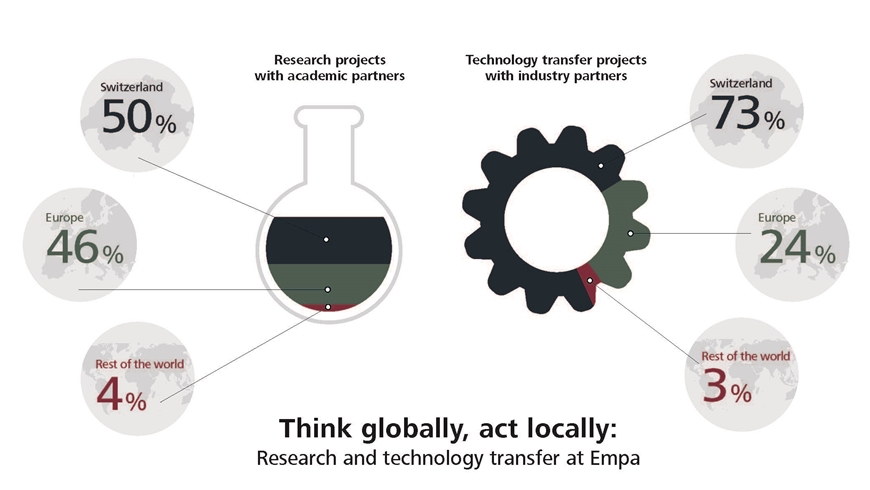From science to industry
Technology transfer at Empa
How do innovations get out of the lab and into the wider world? There are different ways, summarized under the term technology transfer. In this interview, Marlen Müller, Head of Knowledge and Technology Transfer at Empa, explains why collaboration with industry is in Empa's DNA, what got Switzerland to the top of international innovation rankings and how researchers benefit from projects with partners from industry.

Marlen Müller, what exactly is technology transfer?
Applied to Empa, technology transfer means bringing research results from our laboratories to industry. At Empa, this happens primarily through direct cooperation with companies or through the founding of spin-offs by our researchers. From a holistic perspective, however, technology transfer also involves the transfer of "brains": When our researchers take up positions in industry or in public administration, they bring the knowledge they acquired at Empa into society.
How important is technology transfer at Empa?
Technology transfer is one of the pillars of Empa, alongside research and teaching. We see ourselves as a bridge between research on the one hand and industry and society on the other. Cooperation with industry is in our DNA: Empa was founded as a materials testing institute. Even back then, the focus was on the benefits for society and the economy. Since then, Empa has evolved into a renowned research institute, but we have always maintained and even expanded our close ties with Swiss industry in particular.

Does this set Empa apart from other research institutions?
Most universities and research institutes now have technology transfer offices. As a materials science institute, however, we have a lot to offer, because practically everything industry does has to do with materials or processes. And this is precisely where Empa has its core competencies: We conduct research on the whole range of materials, from wood and ceramics to nano and quantum materials, thin films and composites. Our researchers have extensive experience with interdisciplinary and transdisciplinary collaboration, and it is quite common for several research groups with different areas of expertise to jointly develop new solutions in industrial projects, thus creating real added value for our partners. Moreover, our demonstrators NEST, ehub and move offer unique platforms to industry to test their innovations under real-world conditions.
Which type of technology transfer is most important for Empa?
Our most important channel for technology transfer to industry is direct collaboration with our industrial partners. We have more than 130 projects with industry every year. These result in products, patents, software and technologies. We contractually regulate the conditions of cooperation as well as the ownership and use of the research results with our project partners. Sometimes, the project ideas come from our researchers, in other cases they arise from a direct need in industry, for example when a company wants to replace a material with an environmentally friendly alternative or optimize a manufacturing process to save energy.
How do companies benefit from such a cooperation?
Our implementation partners are often Swiss SMEs that are too small to operate their own R&D sections. Personnel, time and resources are also often scarce. However, many Swiss SMEs are global players, where they must assert themselves against international competition. Joint Innosuisse projects with Empa strengthen their innovative edge and thus the Swiss economy as a whole. But cooperation with us is also attractive for large companies. Even if they conduct their own research and development, they can venture closer to basic research with us. In Empa's demonstrators, they can test new technologies and materials in a real-world environment. A prime example of this is the brand new NEST unit, STEP2, which focuses on new digital design and production technologies with innovative materials and a comprehensive energy and comfort concept. The unit was planned and built together with BASF and other industrial partners.
And what do the researchers get out of it?
During industrial projects, our researchers can still publish their results after consultation with our partners. This is contractually regulated, as academic work is extremely important for our researchers, especially our doctoral students. At the same time, collaboration with industry is a valuable experience for young researchers. It is not uncommon for them to find jobs in industry through Innosuisse projects.
Switzerland is considered an extremely innovative country. Do we also have a well-established technology transfer to thank for this?
Switzerland is a knowledge society. We have few natural resources, so we have always had to secure our prosperity through innovation. We are particularly strong when it comes to the number of patent applications, which has earned us first place in the Global Innovation Index (GII) and similar rankings. However, we must not rest on our laurels: Great ideas alone are not enough; innovation is about actually bringing these ideas to market, i.e. introducing new or improved products, services or processes. Not to forget, countries such as China are catching up fast.
What does the future of technology transfer at Empa look like?
In future, we want to support our industry partners more closely once the project has been completed. Before the new process is implemented or the new product is launched on the market, the partner still needs to take a few important steps. This can be a challenge for SMEs in particular. In the longer term, we are currently observing a trend towards open source in research: More and more research funding agencies such as the EU are demanding open source approaches and open access to research data as a prerequisite to obtain funding. This has a huge impact on technology transfer. If a partner can no longer obtain exclusive rights to use a certain technology, they may be less willing to invest in research. We may be able to find a middle ground here and make results from the early phases of the project freely available, while the later findings are more likely to be patented. A balance between open source approaches and the protection of intellectual property will be crucial.
Technology transfer
How do innovations get out of the lab and into the wider world? There are different ways, summarized under the term technology transfer. At Empa, technology transfer takes many different forms – be it through direct industry cooperation, Innosuisse-funded projects or by founding start-ups. If these endeavours are ultimately successful, they result in innovative products and solutions that make our world a little bit better.
Read the latest EmpaQuarterly online or download the PDF version.
-
Share
|
Products with "Empa inside" Technology transfer is a long and complex, sometimes tedious process. Not all research projects lead to a market-ready product – but some do. Here you will find a selection of products in whose development Empa has played a significant role. Some have been on the market for some time, others hit the shelves only recently. What they all have in common: They contain a piece of Empa. |
|
Best of Empa spin-offs If no industrial partner can be found for a promising new technology, researchers frequently become entrepreneurs themselves. Spin-offs are young companies that emerge directly from Empa's research. They develop products and services that do not yet exist – as these four examples show. |
|
Research meets industry Innosuisse, the Swiss innovation promotion agency, supports research-based innovation in order to strengthen the competitiveness of the Swiss economy. As part of Innosuisse projects, companies work together with universities or research institutes such as Empa to bring innovative ideas to the market. Empa is currently involved in around 80 running projects of this kind. Here are four of them. |






